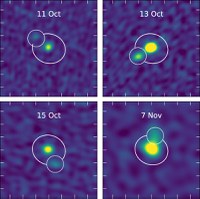Kuiper Belt Objects & Their Moons
 Most of the largest objects in the Kuiper Belt are known to have one or more satellites orbiting the parent body. The majority of these satellites have a small fractional brightness compared to their parent body. Even before the discovery of any of these small satellites, models predicted that giant impacts onto differentiated bodies would preferentially form icy satellites with a small fractional mass. Many of the known satellites to large Kuiper Belt Objects (KBOs) appear consistent with this paradigm. While satellites of mid- to small-KBOs tend to be similar in size and brightness to their primaries, the largest KBOs preferentially have satellites with small fractional brightness. In the two cases where the sizes and albedos of the small faint satellites have been measured, these satellites are seen to be small icy fragments consistent with collisional formation. In this research, the authors examine Dysnomia and Vanth, the satellites of Eris and Orcus, respectively. Using ALMA, the authors obtained the first spatially resolved observations of these systems at thermal wavelengths. Vanth is easily seen in individual images, and Dysnomia was detected at the 3.5σ level by stacking all the available data on the known position of the satellite. The diameter of Dysnomia and Vanth were calculated to be 700 ± 115 km and 475 ± 75 km, respectively, with albedos of 0.04 and 0.08, respectively. Both Dysnomia and Vanth are indistinguishable from typical Kuiper Belt objects of their size.
Most of the largest objects in the Kuiper Belt are known to have one or more satellites orbiting the parent body. The majority of these satellites have a small fractional brightness compared to their parent body. Even before the discovery of any of these small satellites, models predicted that giant impacts onto differentiated bodies would preferentially form icy satellites with a small fractional mass. Many of the known satellites to large Kuiper Belt Objects (KBOs) appear consistent with this paradigm. While satellites of mid- to small-KBOs tend to be similar in size and brightness to their primaries, the largest KBOs preferentially have satellites with small fractional brightness. In the two cases where the sizes and albedos of the small faint satellites have been measured, these satellites are seen to be small icy fragments consistent with collisional formation. In this research, the authors examine Dysnomia and Vanth, the satellites of Eris and Orcus, respectively. Using ALMA, the authors obtained the first spatially resolved observations of these systems at thermal wavelengths. Vanth is easily seen in individual images, and Dysnomia was detected at the 3.5σ level by stacking all the available data on the known position of the satellite. The diameter of Dysnomia and Vanth were calculated to be 700 ± 115 km and 475 ± 75 km, respectively, with albedos of 0.04 and 0.08, respectively. Both Dysnomia and Vanth are indistinguishable from typical Kuiper Belt objects of their size.
Image: ALMA observations of the Orcus–Vanth system. The images are centered on Orcus, and the predicted position of Vanth is circled. Tick marks in the images are 200 milli-arcseconds. Vanth is clearly detected even in the lower-resolution November 7 data.
Publication: Michael E. Brown (California Institute of Technology) & Bryan J. Butler (NRAO), Medium-sized Satellites of Large Kuiper Belt Objects, Astronomical Journal, 156, 164 (October 2018).




Connect with NRAO